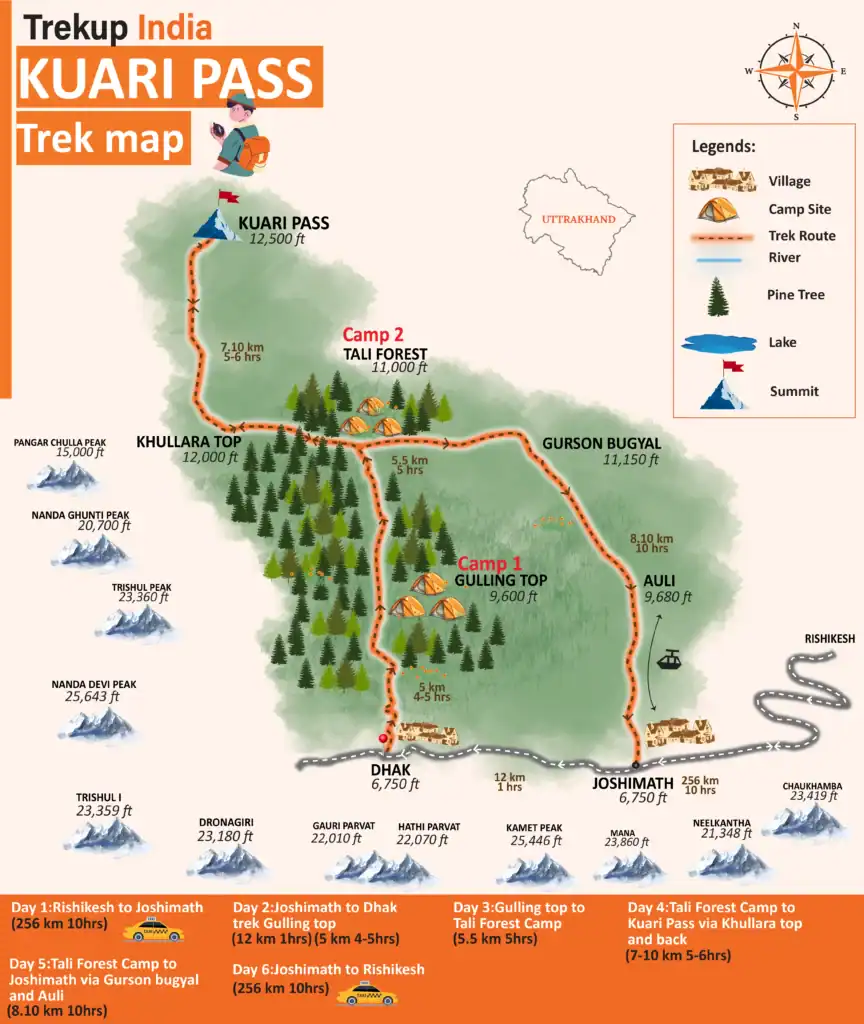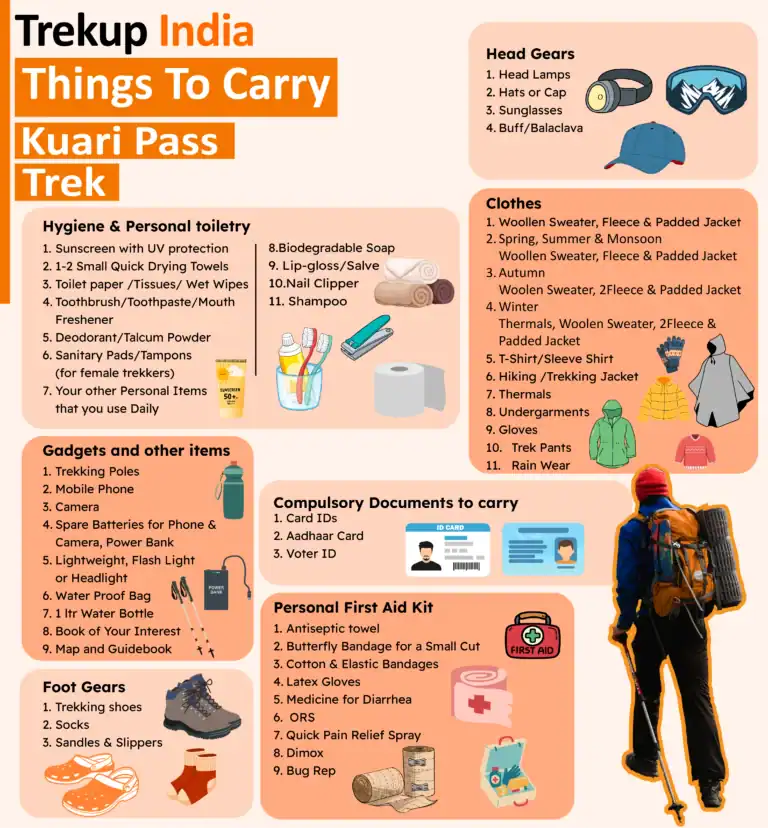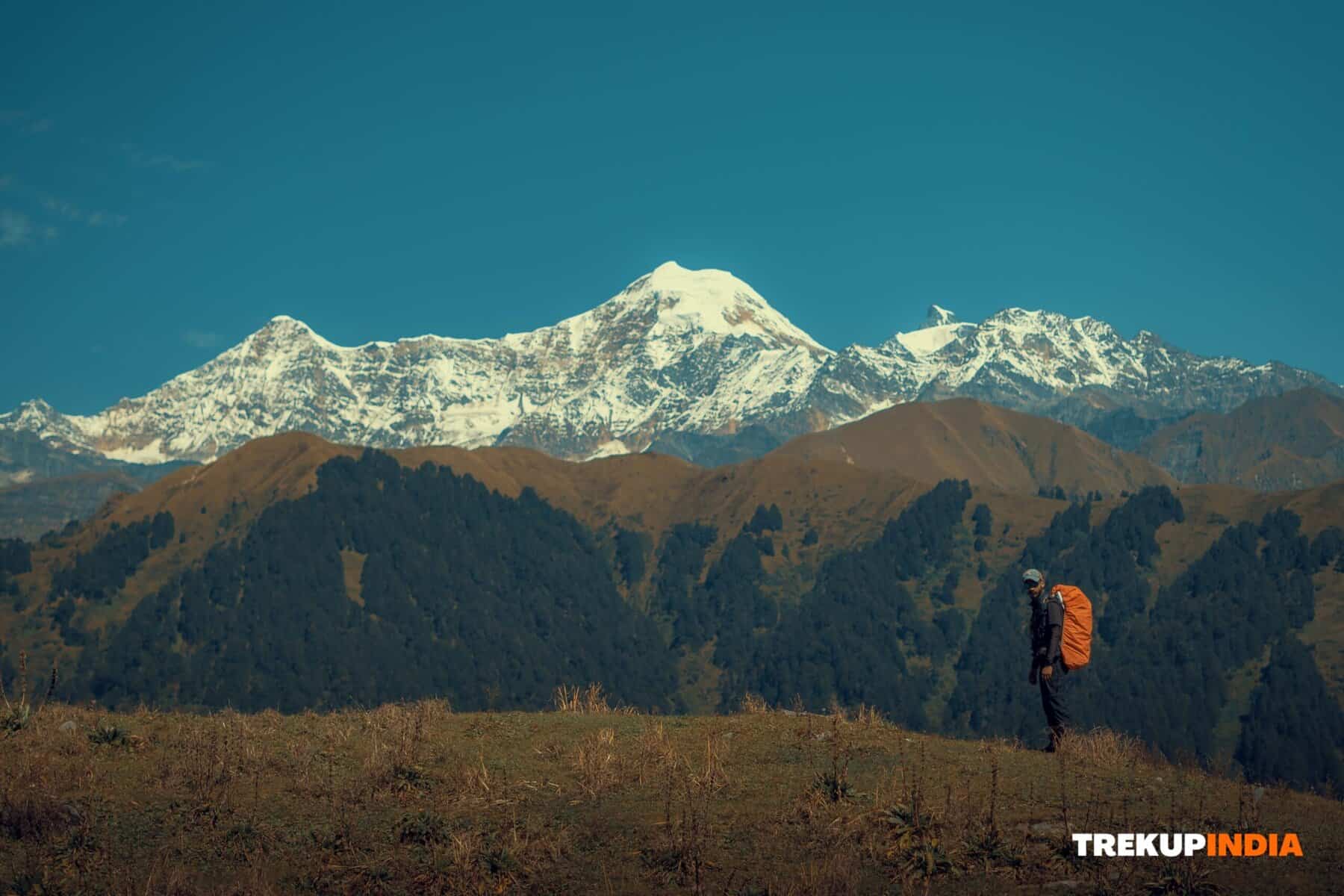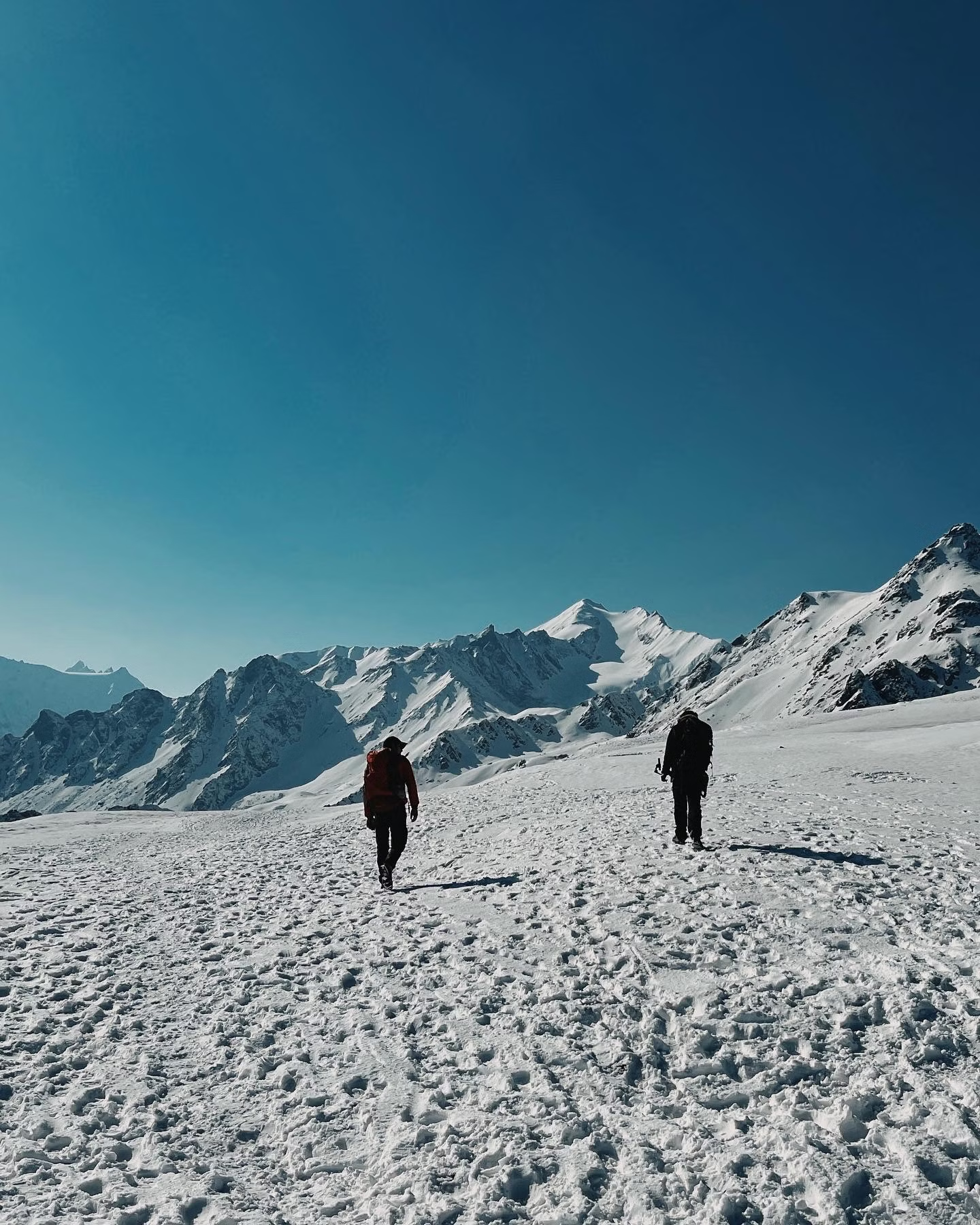Trek Grade
Moderate to Difficult
Highest Altitude
12,516 ft
Base Camp
Joshimath
Best Time
Oct to Mar
Trek Distance
30 Km
Not sure which trek is right for you? Trekup India’s Mountain Experts have you covered.
Not sure which trek is right for you? Trekup India’s Mountain Experts have you covered. From figuring out if a trek matches your fitness level to knowing who you’ll be trekking with, we’re here to answer all your questions. Reach out to our Mountain Experts and plan your trek with confidence.
Kuari Pass Trek
Whether you are an experienced trekker or a beginner, the Kuari Pass Trek is a trek you must do. It’s a must to see the stunning views of India’s most famous mountains, including Mt. Nanda Devi (25,673 feet) and Mt. Dronagiri (23,182 feet) In any season. Of the numerous things Lord Curzon accomplished in India, the most popular is the exploration and propagation of a trek route beginning at Joshimath through Kuari Pass in the Garhwal Himalayas. At 4264m, Kuari Top is like an arena, where the Himalayan mountains that have stood the test of time play their part. The 7000m club comprises Kamet (7756m), Trishul (7120m), Chaukhamba (71 Kamet (7756m), Trishul (7120m), Chaukhamba (7128m) and the fantastic majestic mountain that is Nanda Devi (7817m) and its twin Nanda Devi East (7434m). More peaks appear impressive: Nanda Ghunti, Hathi Ghoda Parbat, Neelkanth, Dronagiri, Mukut Parbat, Mana, Rishi Pahad, and Changbang, among others. Kuari Pass Trek, Kuari Pass Trek, allows you to see this stunning mountain range from a close-up.
In winter, there’s an additional reason to visit. While most other mountain passes within the Himalayas are covered with snow, the Kuari Pass is only an accessible mountain pass during the winter. While you aren’t traditionally crossing the pass, you walk to the pass to take in the breathtaking views from the top.
The Kuari Pass trek begins at Joshimath within the Chamoli district of the Himalayas, which has grown into the leading destination for trekkers and pilgrims from this part of the Himalayas. To start, Kuari Pass is a four-day trek (6 days when you count the days of travel from Rishikesh to Joshimath and Return). Visit famous pilgrim cities like Rishikesh, Devprayag, Joshimath and Haridwar. The Kuari Pass trek within the Garhwal Himalaya is 31 km long. It is well-known for its ability to look out over India’s second-highest peak, Mount Nanda Devi.
The Kuari Pass trek at an altitude of 12,516 feet. Provides you with views from the summit of Dronagiri, Chitrakantha, Chaukhamba and Tali High. The Interlude of meadows and beautiful forests bursting with rhododendrons and oak trees makes your trek more attractive. On the way, you will also enjoy the breathtaking sights of the holy rivers like Bhagirathi and Alakananda, making the climb more thrilling.
Differently, snow can be an experience all on its own in this trek. The snowy floor of this perfectly crafted forest and snowflakes settling upon the Oak leaves, an un-smooth carpet will take you straight to the landscape that would be Santa’s admiration.
The most refreshing aspect of the trek is traversing the gorgeous Himalayan meadows. They are referred to as “Bugyals” in the local language. It would help if you did not skip over the serenity and beauty of the Himalayan meadow. The most impressive is Gorson Bugyal, consisting of vast green pastures that undulate. Along this trek, you’ll also be able to visit Auli, famous for its gorgeous ski slopes during winter.
Kuari Pass is an easy-moderate trek that is simple enough for anyone who wants to start on the Himalayas.
The Kuari Pass trek will take you through several lesser passes, including the Vinayak Pass and Tali Top. They eventually lead you to the trek’s highest point, the Kuari Top, which is 13990 feet. The trek is simple and will pay enormous dividends for your physical exertion, with stunning views of the most beautiful mountains of the Himalayan Range. The spectacular view of the Nanda Devi Massif is the main attraction of this trek. So, if you’re looking to spend some time in the meadows or the snowy slopes of the Garhwal Himalayas, then pack your backpacks and set off toward Haridwar. Trekup India will take you along the Curzon Trail through Kuari Pass while you enjoy the stunning views.
Trek Cost
-
Twin-Sharing Tent Accommodation Provided
-
Pickup from Natraj Chowk, Rishikesh at 6.30 A.M & will drop at same location by 7 P.M
-
+₹1600 Extra For Transport
Fix Departure Dates!
Trek Cost Inclusions and Exclusions!
Trek Cost Inclusions
- Stay: 3 Nights of tented accommodation at individual campsites of Trekup India on twin sharing and 2 nights at Trekup India guest house at Joshimath on multi sharing.
- Meals: Trekup India will provide freshly cooked meals during the trek starting with Dinner on Day 1 to tea, coffee on day 6 (Meals are simple, nutritious, and vegetarian)
- Transport (Optional): Rishikesh to Joshimath and return. ( 1600 extra )
- Trek Insurance (Optional): Trekup India recommends that all trekkers consider getting trek insurance. This is optional, but highly recommended. Trek insurance covers unexpected events that may occur during your trek. The cost of the insurance starts from INR 210. Please read more about what is included in the coverage and why it is mandatory on treks.
- Trek Equipment: Sleeping bag, Sleeping tents, Kitchen tent, Dining tent, Toilet Tent.
- Amenities: All utensils, sleeping mattresses (Black foam mats), Crampons, and Gaiters for snow.
- Health & Safety: First Aid Box, Oxygen Cylinders, Stretchers, Oxi meters, BP Machines, health.
- Permits: Forest Permits and Camping Permission Fee
- Trek Crew: High Altitude Chef, Helpers, Trek Leader & Guides, and other support teams.
- Potters & Mules: Potters and Mules are to carry all trekking equipment, ration, and vegetables.
Trek Cost Exclusions
- GST 5% (it is Mandatory)
- Any Meals/accommodation beyond the itinerary or not mentioned in the program.
- Any Bus / Airfare to/from trek start/end point
- Personal Medical expenses do carry your medication.
- Any personal services such as Laundry, phone calls, liquors, mineral water, etc.
- Any still / video camera fee
- Any Entrance fee Monuments, Monasteries, Museums, Temples – Pay directly on the spot.
- Backpack Offloading (Mule/Porter Charges)
- Offload Charges: ₹1680 per bag for the full trek if paid online in advance.
- On-spot Payment: Charges may increase by up to 30% if paid at the base camp.
- Weight Limit: Each bag must not exceed 10 kg.
- Note: Offloading is optional and is recommended for those who prefer to trek with a lighter daypack.
- Any emergency evacuation charges
- Any services that are not mentioned in the cost inclusion section.
Kuari Pass Trek Videos
Videos by experts watch these videos to prepare well for a Successful Trek
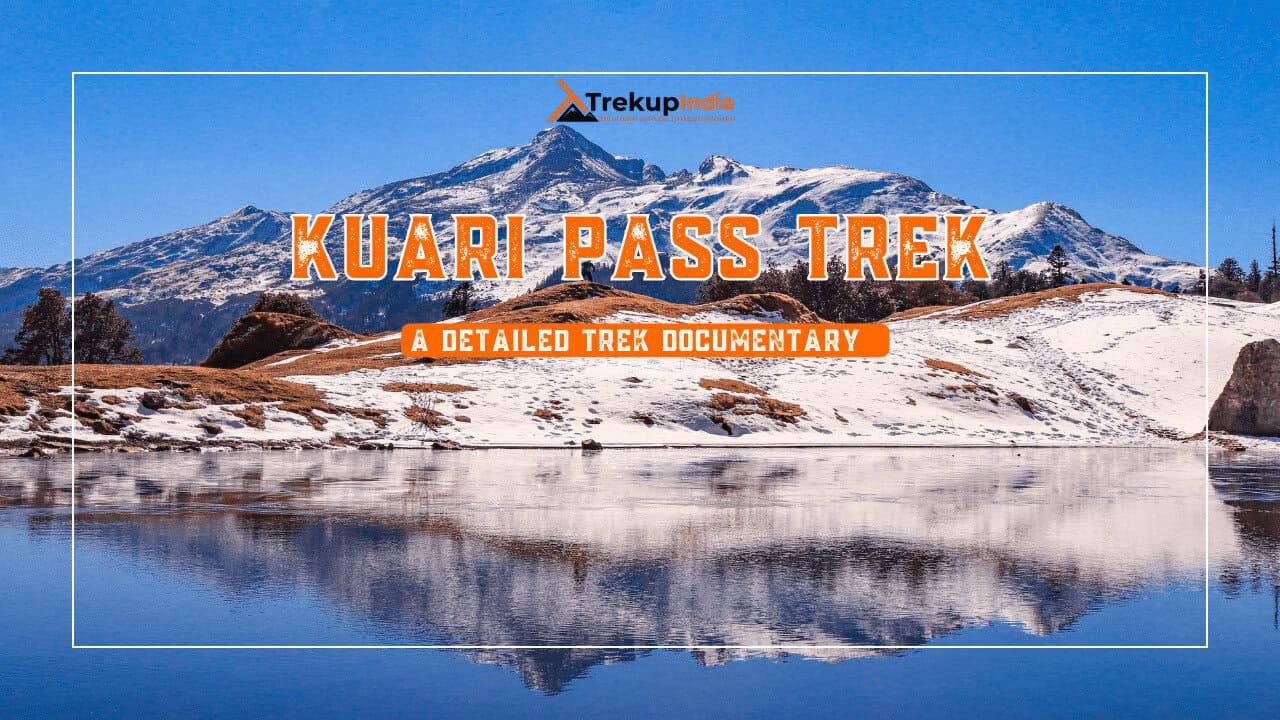
Want To Trek Like Pro?
Basically, watch these videos if you want to trek the same way professional trekkers do and make your skills better. These videos contain useful tips and techniques to further improve your trekking skills itself. These videos actually help both new and experienced trekkers improve their trekking skills. These videos definitely provide useful tips that make your trek better. We are seeing that these videos by Trekup India experts will only help you make your trekking skills better.







Know Everything About Acute Mountain Sickness
Acute Mountain Sickness occurs when people trek to high altitudes above 8,000 feet. This condition itself develops further due to reduced oxygen levels at such heights. Basically, as you go higher up, the air pressure and oxygen levels decrease, which causes the same problem. Acute Mountain Sickness surely causes headache, nausea, vomiting, and dizziness in affected persons. Moreover, peoples also experience difficulty in sleeping during this condition. To avoid mountain sickness, you should actually trek up slowly to higher altitudes. To learn further about this condition itself, watch the videos by Trekup India.

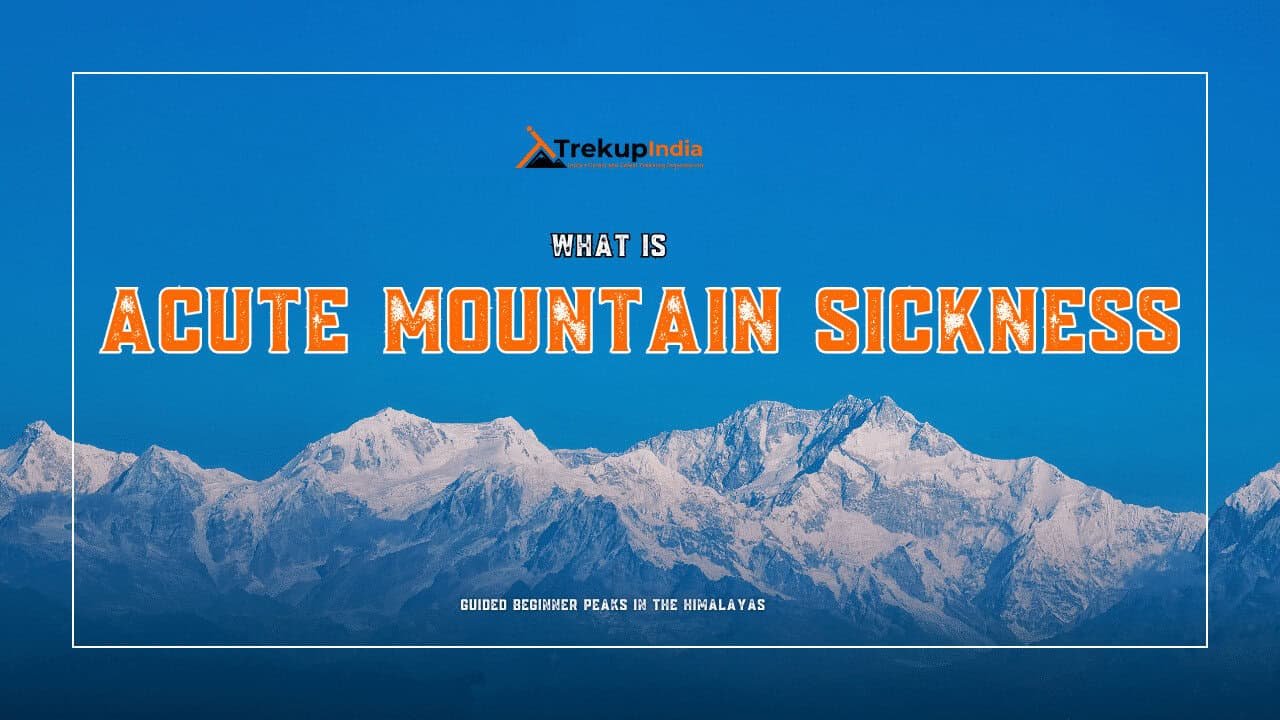
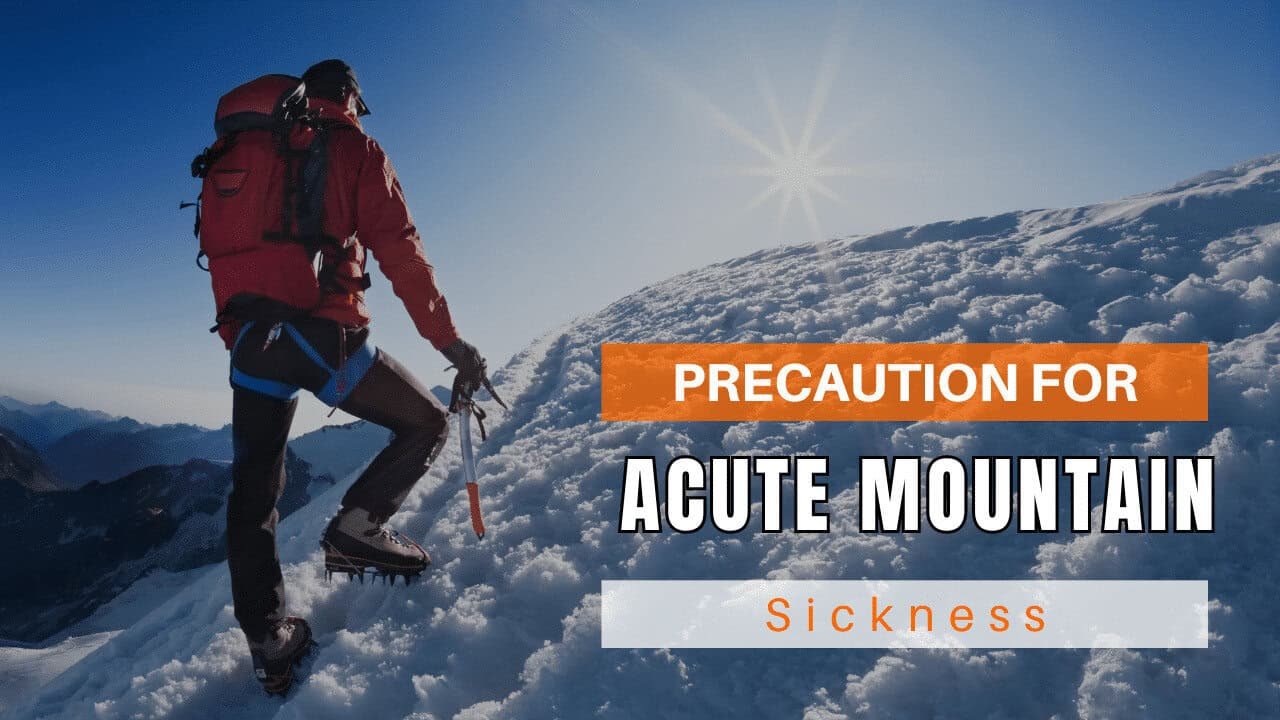
Day Wise Detailed Itinerary of Kuari Pass Trek
Day 1: Pickup From Rishikesh and Drive to Joshimath
- Altitude: 2,050m/6,750ft
- Drive Distance: 256 Kms
- Drive Duration: 10 Hrs
- The trekkers are picked up from Rishikesh by 6:30 AM a Bolero or comparable car (cost includes)
- You can have breakfast and Lunch along the way (exclusive of cost)
- It’s a long trip from Rishikesh to Joshimath on the way. During the journey, you’ll see a variety of stunning views of the various cities that will pass by your route.
The trek starts from Rishikesh. The pick-up location will be the Rishikesh, and we will then travel through Badrinath Road.
If you’re passionate about the culture of sightseeing and adventure water sports, then you may want to plan a short stay in Rishikesh before your trek or after your trek.
The 10-hour drive to Joshimath is bound to be lengthy and exhausting. However, you will never get bored with the breathtaking views. The magnificent river that flows with us in parallel will become more thrilling and wilder as we climb upwards. We’ll be passing through panchprayag. panchprayag also known as the 5 holy confluences in Ganga-Devaprayag, Rudraprayag, Karnaprayag, Nandaprayag and Vishnuprayag.
Keep your cameras at hand and stay awake throughout the trip.
Day 2: Joshimath to Dhak By Drive and To Gulling top by Trek
- Altitude: 2,900m/9,600ft
- Drive Distance: 12 Kms
- Drive Duration: 1 Hrs
- Trek Distance: 5 Kms
- Trek Duration: 4-5 Hrs
- The route will take you to Joshimath up to Dhak village, which is 12km drive(2,050m/6750ft)
- The trail is made up of gradual and steep ascents and passes in the midst of villages.
- Enjoy the delicious hot Lunch at the campsite
- You’ll be able to see some of the stunning mountain ranges Dronagri, HathiParvat, and GoriParvat
- The trek will begin starting from Dhak village and continue to Gulling top campsite, which is 5 km of trek.
- The trek will provide stunning views of the peaks as well as grasslands and more while you hike.
- Stay the night in tents on twin sharing.
A series of ice-capped mountains will greet us in Joshimath, which will appear more welcoming today than in the dawn of our journey to our base camp the first day. After breakfast, which is early this day, we’ll take off for Dhak village, located in the Joshimath Tehsil, which is a rough journey of about 45 minutes. From here, our trekking will begin. Be on the lookout towards the gentle slopes that make up The Sleeping Lady Mountain of Joshimath during this trek. The gentle slopes appear to create an outline of a sleeping lady.
The trek begins starting from Dhak with a steady ascent. The dirt path diverges from the road and climbs toward Tugasi village. There are a few abrupt T-turns along this trail. After that, the walk begins on flat ground, followed by slowly rising slopes gently. The terrain is generally rough in this area. In the area left of the terrace farms, there is not a lot of greenery. However, it offers a panoramic panorama across the Garhwal frontier in all directions. Be on the lookout for the shining silvery sun-dazed stream of Dhauli-Ganga, which is snaking into the abyss. Also, look out for the Hydroelectric Vishnugad Tapovan Power Station. You won’t discover any snow in the area.
About twenty to twenty-five minutes into the hike, it will take you to Kharchi village. You will get your bottles filled and take some time for yourself. The trail continues from Kharchi on the same rough path with the valley extending towards the right. The climb is steep and includes some switchbacks until it reaches the Lower Tugasi region. The trail is split in two, and you must choose the one that runs along with a hydro-powered flour mill. Within 10 minutes, you’ll reach an area known as the Upper Tugasi region, marked with flower beds, wheat fields and thatched roofed houses. There are also a few streams flowing through the region.
Follow this route with a steady climb leaving the farmland to the left, and you’ll be greeted by the breathtaking view of Dronagiri mountain rising in terror from an infinity. We will pitch tents in open meadows with ideas of Dronagiri and surrounded by oak forest.
You may request your trek leader to guide the group on a hike up to Gulling Top point this afternoon to experience the snow-covered forests on your own. Prepare yourself for the most stunning views that stretch across the Dronagiri peak that is caught by the glimmering dawn light that emanates from this campsite at dawn the next day.
Day 3: Trek From Gulling Top to Tali Forest Camp
- Altitude: 3,350m/11,000ft
- Trek Distance: 5.5 Kms
- Trek Duration: 5 Hrs
- 5.5 km, which is approximately 5 hours
- A hike will take you up the steep climb through rhododendron, oak (mostly white and pink) and walnut forests.
- You’ll be amazed when you experience the stunning beauty of this dark forest and nature trails
- Take advantage of the delicious lunch served on the campsite.
- Staying in tents for the night.
Make sure you wake up on time the next morning to begin the 5 hour trek into the forests of Talli. After the arduous climb of the previous days, the climb today will be easier. The ascent slope are fairly smooth and give you a pleasant walk.
About 20 minutes into the hike and you’ll arrive at an open green area that overlooks the majestic snow-capped mountains. After a short period of rest, you will need to continue, crossing a small stream, before you enter an ever-growing mixed forest that is slowly growing with rhododendrons, oaks, and rho. If you’re visiting to the area in late March, you may have a few white and pink blooms. In addition to rhododendrons see walnuts as well as other kinds of conifers the area.
At the peak of winter’s beauty it is possible to find every aspect of the forest covered with snow. In the snow that is thickening with its light, shade, and of the coniferous forests of Gulling the second camp during your trek is set up.
Along this route the Hathi-Ghori peaks are expected to be bursting forth in splendor, along with Dronagiri which is now a little towards the right.
Day 4: Via Khullara Top Trek From Tali Forest Camp to Kuari Pass and Back
- Altitude: 3,800m/12,500ft
- Trek Distance: 7-10 Kms
- Trek Duration: 5-6 Hrs
- Enjoy a delicious breakfast before you head out on the trail.
- The first half of the climb is an ascent of a mountain while the second half is an ascent that is gradual.
- The wide meadows that have the golden to bright green grass covering during summer. They transform into rolling snowfields during the winter.
- Journey towards the Khullar summit to the bridge that is broken with a frozen stream (12,200 feet)
- From the bridge that is broken, you’ll be heading towards Kuari pass. Kuari passing (Strenuous ascent) (12,500 feet)
- It is recommended to carry sufficient water since there is no water source along the route.
Fourth day is summit day which is likely to last between 10 and 11 hours, depending on your group’s speed. You must dress to be prepared for the high snow and squalling winds along the slopes of today. There will not a single source of water in the coming days, so ensure you have enough water to last your needs throughout.
In the initial phase the hike will take you towards the Khullara summit, a moderate climb of 3.5 kilometers.
The fourth day is summit day which is likely to last between 10 and 11 hours, depending on your group’s speed. You must dress to be prepared for the high snow and squalling winds along the slopes of today. There will not be a single water source in the coming days, so ensure you have enough water to last your needs throughout.
The hike will take you towards the Khullara summit, a moderate climb of 3.5 kilometers in the initial phase. It will require you to cross an unbroken bridge and streams frozen in the peak of winter, then a ridge climbs up to the highest point, extraordinarily strenuous and challenging due to the snow. Each 15-minute interval, you’re allowed to stop and take a breather. In Jhandi Dhar, a suitable place to rest for two hours into the hike, it is possible to take the time to take a break for a while. Lunch can be eaten in the middle of the trek or upon getting to the temple at the foot of the Kuari High Pass.
Be sure to tighten your shoes properly. Trekup India will give you high-quality crampons; However, you are required not to carry the gaiters you own. Gaiters can be purchased from the local market in Joshimath for a reasonable cost.
The summit of this trek is an explosion of images that reveal many Garhwal gigantic peaks. They reveal Kedarnath Peak Kedardome, Chaukhambha, Balakun, Neel Kantha, Mukut Parvat, Kamet, Abhi Gamin, Mana I, Ghori Parvat, Hathi Parvat, Dronagiri, Kalanka, Changabang, Nanda Devi, Nanda Ghunti.
Cross an unbroken bridge as well as streams that are frozen in the peak of winter, then a ridge climb up to the highest point, extremely strenuous and difficult due to the snow. Each 15 minute interval, you’re allowed to stop and take a breather. In Jhandi Dhar, a suitable place to rest for two hours into the hike it is possible to take the time to take a break for a while. Lunch can be eaten in the middle of the trek or upon getting to the temple at the foot on the Kuari High Pass.
Be sure to tighten your shoes in a proper manner. Trekup India will give you with high-quality crampons However, you are required not to carry the gaiters you own. Gaiters can be purchased from the local market in Joshimat for a reasonable cost.
The summit of this trek is an explosion of images that reveal many Garhwal gigantic peaks. You can get view of Kalanka, Balakun, Hathi Parvat, Mana I, Ghori Parvat, Nanda Ghunti, Abhi Gamin, Neel Kantha, Mukut Parvat, Kamet, Chaukhambha, Kedarnath Peak Kedardome, Dronagiri, Changabang, Nanda Devi,
The beauty of this image is unparalleled.
Day 5: Via Gurson bugyal (11150 ft), and Auli (9680 ft), Tali forest camp to Joshimath
- Altitude: 2,050m/6,750 ft
- Breakfast at Camp.
- There is a packed lunch during the journey
- It is possible to have meals as well as snacks in Joshimath when you get there.
Today, we’ll head toward Auli, the capital of skiing in India and one of the most renowned in south Asia. While exploring the stunning snow-covered valleys that roll down to Gorson Bugyal, we will return to Auli on a delightful trip. Walking through the Bugyals that lie in Gorson is free of any difficult or grueling climb, mainly on flat terrain, although the winter snowfalls of high winter could make the area a little drab. When the winter thaw is in March, skiing is a significant sport.
When you reach Auli, the cable-car ride takes you to Joshimath, which is floating above the breathtaking ski resort, gentle snow-covered slopes, and the browning forests of pine.
Day 6: After Having Last Breakfast With Us, Departure from Joshimath to Rishikesh
- Altitude: 12,000 ft – 12,000ft
The ride will begin at 6 am and will reach the final destination by 8 pm.
You can book return tickets to your home town after it.
We’ve prepared a comprehensive Trek Route Map for your upcoming adventure to Kuari Pass Trek, which outlines the entire journey including all stops and trails. This map provides detailed information on the terrain, distance between points of interest, and estimated travel time to help ensure a safe and enjoyable trek. We’ve carefully curated the map to ensure that you have all the necessary information at your fingertips. Please take a moment to review it thoroughly, and don’t hesitate to reach out if you have any questions or concerns.
The Kuari Pass Trek Altitude Chart Altitude Chart is a useful tool for Trekkers to monitor their altitude changes during their rides, allowing them to plan their routes more efficiently and track their progress over time. This Kuari Pass Trek chart is beneficial for both casual and experienced Trekkers, helping them make the most out of their Trek experience.
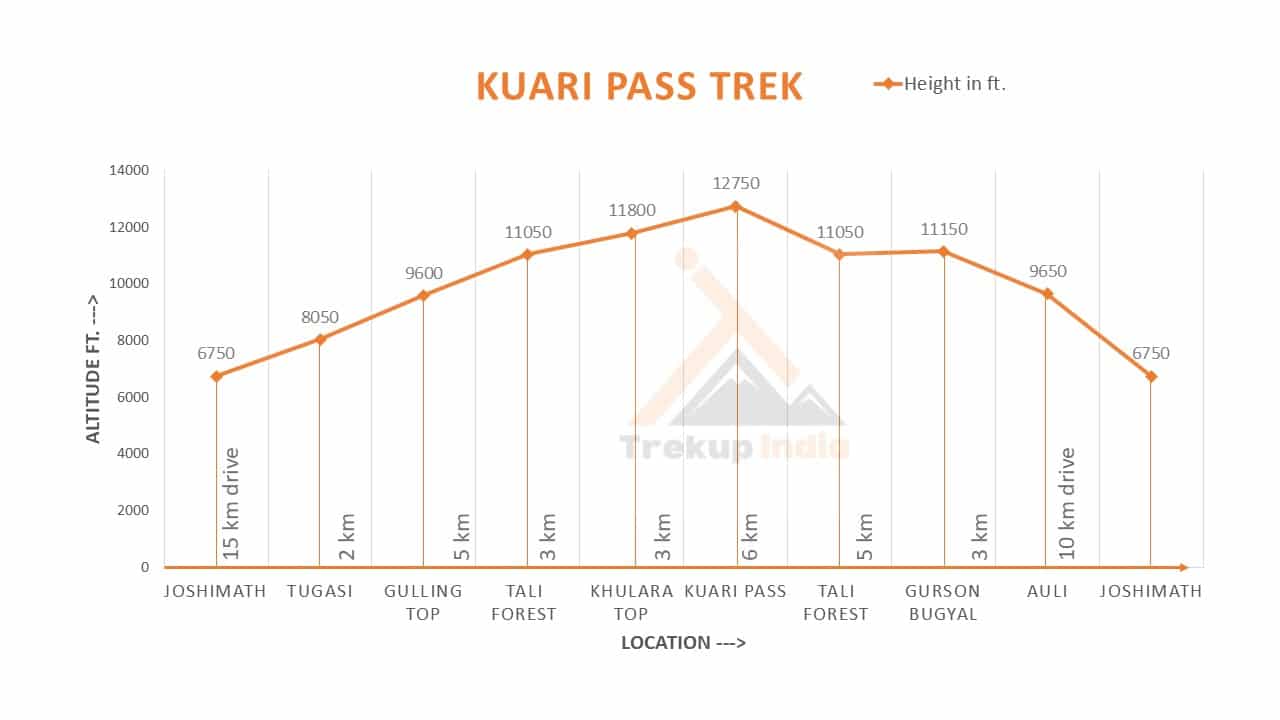
Trek Cost Inclusions
- Stay: 3 Nights of tented accommodation at individual campsites of Trekup India on twin sharing and 2 nights at Trekup India guest house at Joshimath on multi sharing.
- Meals: Trekup India will provide freshly cooked meals during the trek starting with Dinner on Day 1 to tea, coffee on day 6 (Meals are simple, nutritious, and vegetarian)
- Transport (Optional): Rishikesh to Joshimath and return. ( 1600 extra )
- Trek Insurance (Optional): Trekup India recommends that all trekkers consider getting trek insurance. This is optional, but highly recommended. Trek insurance covers unexpected events that may occur during your trek. The cost of the insurance starts from INR 210. Please read more about what is included in the coverage and why it is mandatory on treks.
- Trek Equipment: Sleeping bag, Sleeping tents, Kitchen tent, Dining tent, Toilet Tent.
- Amenities: All utensils, sleeping mattresses (Black foam mats), Crampons, and Gaiters for snow.
- Health & Safety: First Aid Box, Oxygen Cylinders, Stretchers, Oxi meters, BP Machines, health.
- Permits: Forest Permits and Camping Permission Fee
- Trek Crew: High Altitude Chef, Helpers, Trek Leader & Guides, and other support teams.
- Potters & Mules: Potters and Mules are to carry all trekking equipment, ration, and vegetables.
Trek Cost Exclusions
- GST 5% (it is Mandatory)
- Any Meals/accommodation beyond the itinerary or not mentioned in the program.
- Any Bus / Airfare to/from trek start/end point
- Personal Medical expenses do carry your medication.
- Any personal services such as Laundry, phone calls, liquors, mineral water, etc.
- Any still / video camera fee
- Any Entrance fee Monuments, Monasteries, Museums, Temples – Pay directly on the spot.
- Backpack Offloading (Mule/Porter Charges)
- Offload Charges: ₹1680 per bag for the full trek if paid online in advance.
- On-spot Payment: Charges may increase by up to 30% if paid at the base camp.
- Weight Limit: Each bag must not exceed 10 kg.
- Note: Offloading is optional and is recommended for those who prefer to trek with a lighter daypack.
- Any emergency evacuation charges
- Any services that are not mentioned in the cost inclusion section.
What should you pack for the Kuari Pass Trek
Kuari Pass Trek is a high-altitude trek. The trekking gear you have to have for this particular trek differs from normal treks. Thus, read this whole segment. There is an important question that the trekker who is doing trek asks, like what all things to carry while trekking. Below, we have provided the details on everything you should take; an easy way to remember is by Head to foot or foot to head. We have prepared from Head to foot.

Head Gears
When trekking it's important to carry headgear to protect your head and face.
Heading out for a trek? Don’t forget to carry headgear to protect your beautiful face and head from the sun, wind, and dust! It’s an essential accessory that keeps you safe and comfortable throughout your adventurous journey. So, make sure you pack it before you step out into nature!
- Head Lamps – When trekking at night, headlamps are essential to illuminate your path while keeping your hands free. Headlamps come in different sizes and lumens, so it is essential to choose one that suits your needs.
- Hats or Cap – Caps or hats are also necessary when trekking in different weather conditions. Caps protect your head from the wind and freezing temperatures at night, while hats provide shade and protection from the sun during the day. It’s essential to ensure that your hat has a strap to prevent it from being blown away by the wind.
- Sunglasses – Sunglasses are also essential for trekking. Your sunglasses should protect your eyes from harmful UV rays and fit your face perfectly to avoid falling off while climbing, jumping, or crossing obstacles. The glass of your sunglasses should also be designed for different weather conditions to provide optimal visibility.
- Buff / Balaclava – Lastly, a buff or balaclava is a must-have to protect your mouth or neck from extreme temperatures and keep them warm. Buffs and balaclavas come in different materials, thicknesses, and designs, so it’s important to choose one that suits your needs and preferences. Depending on the weather conditions and your activities, you can wear them as neck warmers, face masks, or headbands.
Clothes
When trekking in high altitudes, prepare for cold weather by wearing layers. Layering traps heat, keeps you warm, and allows you to easily adjust your clothing as temperatures fluctuate.
Layering is important for different seasons when trekking. When planning a high-altitude trek, it is important to prepare for the cold weather. Wearing layers is the best approach as it provides both protection and flexibility when the weather changes frequently in the mountains. Layering helps to trap heat and keep your body warm, while at the same time allowing you to easily adjust your clothing as the temperature fluctuates. By wearing layers, you can enjoy your trek comfortably and stay safe in the unpredictable mountain weather
- For spring, summer, and monsoon treks, consider wearing three layers: a woollen sweater, a fleece, and a padded jacket.
- For autumn treks, add one more fleece layer to make it four layers.
- For winter treks, you may need five layers with thermals, a woollen sweater, two fleeces, and a padded jacket.
- T-shirt/sleeve shirt– Bring three T-shirts and two quick-dry trek pants, wearing one and carrying the others. Long sleeve shirts help to protect from sun UV rays. We recommend synthetic T-shirts as they get dry quickly when they get wet.
- Hiking / Trekking Jacket– down jackets (-5 to-10 C) or two-three-layer jackets.
- Thermals– at least two pairs of thermals help keep the body warm during cold weather.
- Undergarments– you can carry them according to your habitual and hygiene requirements.
- Gloves– 1 pair of gloves will keep your hand warm and nice.
- Trek Pants– Bring 2 to 3 comfortable trekking pants. Trekking pants play a significant role, as they are designed for comfort and mobility, making trekking easier. It should be Synthetic so that it gets dry quickly when wet.
- Rain Wear– you can carry a raincoat or Poncho. During long rains and snowfalls, the waterproof jackets start leaking. Still, the Poncho and raincoats keep you dry, so choose accordingly.
Tip: If you choose a raincoat on your trek, carry a small waterproof cover so things inside your backpack can’t get wet. If you carry a Poncho, you don’t need to worry. It protects both you and your backpack.
Foot Gears
When it comes to planning a trek, one of the most important aspects is to ensure that you have the right kind of foot gear.
- Trekking shoes which are waterproof and have ankle support. Walking / Hiking sandals which can be used off the trek, i.e., in the morning and evening hours when you reach the campsite, basically to get your feet rest from heavy boots, sometimes used for crossing streams and rivers, it’s more comfortable and safer than crossing barefoot or wetting your shoes. Sneakers (Optional) can be worn for normal driving days or used around the camp.
- Socks– you should at least carry 3 to 4 pairs.
- Microspikes & Gaitorswill be provided by Trekup India when required. You don’t have to carry them.
Personal First Aid Kit
Don't forget to pack your personal first aid kit! It's always better to be safe. So, make sure you're prepared for any unforeseen circumstances.
Below are some common medicines generally required/used during your adventure trip; however, please consult your doctors prior.
- Antiseptic towel or water syringe (to clean the wound)
- Butterfly bandage for a small cut
- Cotton and elastic bandages and sterile gauze pad for larger wounds
- Latex gloves are used when the wound bleeds.
- Medicine for Diarrhea (Upset stomach)
- Medicine for cold, flue/fever, headache
- Some pain killers
- ORS pouches
- Quick pain relief spray (External use)
- Any personal medicine prescribed by your doctor
- Dimox / Similar for high altitude sickness
- Bug Repellent
- Carry some nutria/energy bars and drinks (non-alcoholic)
- Note: Kindly consult your doctor before purchasing or taking any medicine.
Gadgets and Other Items
You might also consider bringing a camera, binoculars, portable charger, and snacks. Be well-prepared and tackle any trail with confidence.
- Trekking Poles
- Mobile phone
- Camera
- Spare batteries for phone and camera, power bank
- Lightweight flashlight or headlight
- A waterproof bag made of plastic is used for the camera.
- Plug/converter for electrical items
- 1-litre water bottle
- A journal with a pen would be a good idea to keep your notes.
- Some book of your interest for the ideal time
- Get into the habit of maintaining a Map and guidebook of the region.
Hygiene & Personal toiletry
Remember to pack hygiene and personal toiletry items such as soap, shampoo, toothbrush, toothpaste, deodorant, and toilet paper.
- Sunscreen with UV protection to shield your skin from harmful rays
- 1 or 2 small quick-drying towels to help you dry off quickly in case of rain or sweat
- Toilet paper, tissues or wet wipes for maintaining hygiene while on the trek
- Toothbrush, toothpaste, and mouth freshener to keep your mouth clean and fresh throughout the journey
- Deodorant or talcum powder to help you stay fresh and odor-free, especially during hot and humid climates
- Shampoo to keep your hair clean and healthy
- Sanitary pads or tampons (for female trekkers) to manage menstrual cycles
- Lip-gloss or salve to protect your lips from dryness and chapping
- Bio-degradable soap to keep yourself clean and hygienic while on the trek
- Nail clipper and other personal items that you use daily
Compulsory Documents to Carry
There are certain documents that you should always carry with you. These documents are not only necessary for your safety and security, but they may also be required by local authorities.
These files must be submitted to the Forest Department before your trek. With none of these, you will not be permitted to trek—original and photocopy of government photo identity card. Carry IDs like Aadhaar, voter ID, etc.
How To Plan Your Trek & Reach Rishikesh Or Haridwar?
To reach Rishikesh, you have a few transportation options:
By Air: The nearest airport to Rishikesh is Jolly Grant Airport, about 25km away. There are regular flights from Delhi to Rishikesh. If you plan to travel by flight, arriving one day in advance is advisable.
By Train: If you prefer to travel by train from Delhi, you must reach Haridwar first and then take a bus to Rishikesh, which is about 35km away.
By Bus: You can take a regular bus from Delhi to Rishikesh from ISBT Kashmere Gate. It’s recommended that you take government buses from this station.
Upon arrival at Rishikesh ISBT, our staff will pick you up, so be sure to reach there. A vehicle will pick you up from Rishikesh ISBT at 6:30 a.m., and you will reach Joshimath by 5:00 p.m.
Fitness Required & Preparation Guide For Kuari Pass Trek
If you’re preparing for a Kuari Pass Trek, Trekup India recommends jogging as part of your fitness routine. Jogging helps work out the same muscle groups that you’ll use during trekking and can help you build endurance. You don’t need any special equipment to get started.
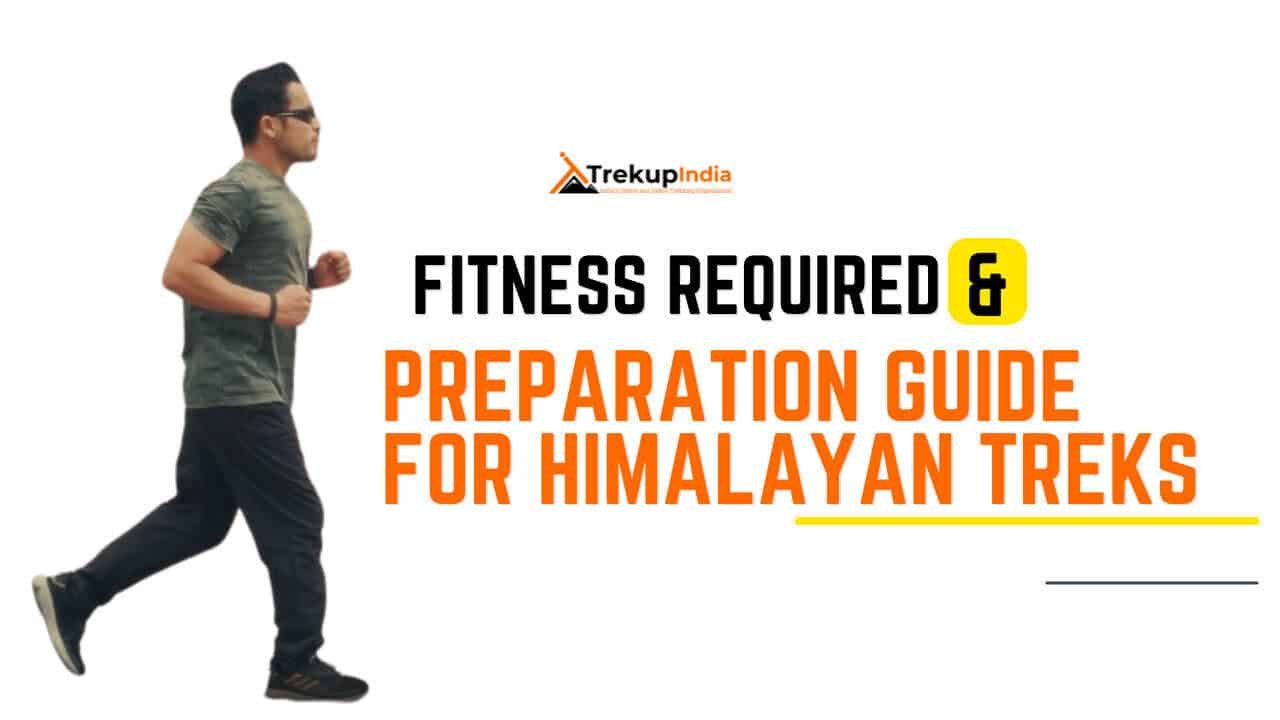
Fitness Target
Trekup India has put the Kuari Pass Trek as moderate grade level trek.
For Moderate – In order to be well-prepared for your upcoming trek, it is recommended that you focus on building your endurance by aiming to cover a distance of 4.5 kilometers in less than 40 minutes. This will help you to develop the necessary stamina and strength required to successfully complete your journey.
How to Achieve This Fitness Target?
To start preparing for your trek:
- Try jogging for at least five days every week.
- If you find 5 km too difficult at first, begin with 2 km and gradually increase over 2-3 weeks.
- Once you feel more comfortable running 5 km, focus on improving your speed gradually on a daily basis.
It is important to ensure that you can consistently complete 4.5 km in under 40 minutes for at least two weeks before your planned trek. Allow yourself 6-8 weeks to prepare physically for the journey.
Strength Training exercises that benefit Trekking
Trekking is an activity that demands a good level of strength.
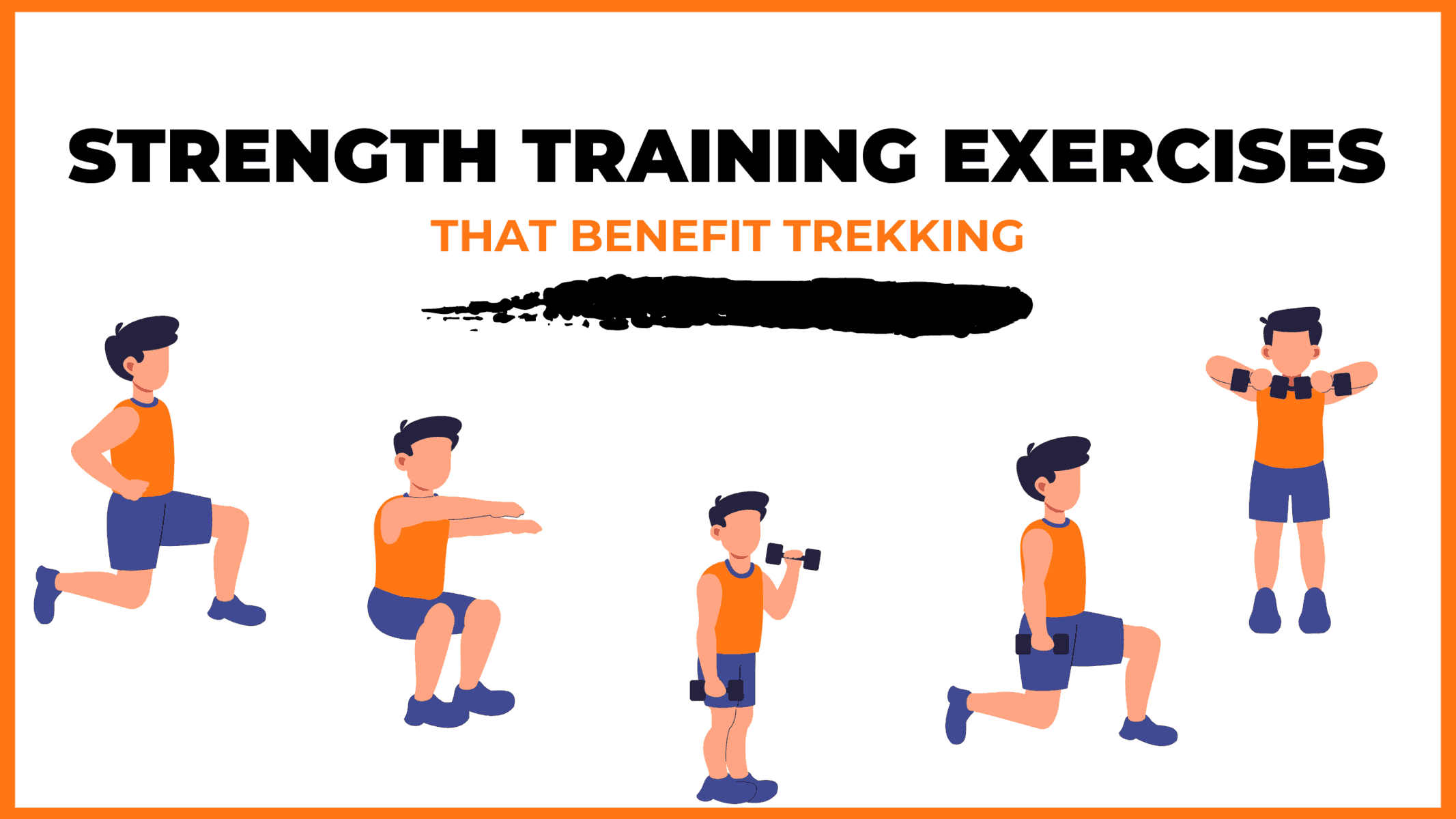
Trekking is a demanding activity that requires good cardiovascular endurance, muscular strength, and overall fitness. To help you prepare for your trek, incorporating bodyweight exercises into your training routine can be an effective way to build strength, improve stability, and enhance endurance, all of which are crucial for a successful trek. In this regard, here’s a breakdown of body weight exercises categorized by the specific body parts they target and the benefits they offer during trekking.
1. Lower Body Exercises
Lower body exercises like squats and lunges are great for building lower body strength, essential for trekking.
a. Squats
Squats are an excellent exercise for building lower body strength, essential for trekking. They target the quadriceps, hamstrings, glutes, and calves. Solid quadriceps and glutes provide power for ascending and tackling uphill climbs, while vital hamstrings aid stability during descents. This is particularly helpful in navigating uneven terrain during trekking.
How to perform Squats Exercises:
- Stand with feet shoulder-width apart, toes pointing slightly outward.
- Lower your body by bending your knees and hips, keeping your back straight.
- Lower until your thighs are parallel to the ground or as low as comfortable.
- Push through your heels to return to the starting position.
b. Lunges
Lunges target the quadriceps, hamstrings, glutes, and calves. They improve lower body strength, balance, and stability, crucial for maintaining control on rocky trails and steep slopes. Additionally, they enhance flexibility, reducing the risk of injury while trekking.
How to Perform Lunge Exercises:
- Stand with feet hip-width apart, hands on hips or sides.
- Take a step forward with one foot, lowering your body until both knees are bent at 90-degree angles.
- Push through the heel of your front foot to return to the starting position.
- Repeat on the other side, alternating legs.
2. Upper Body Exercises
Upper body exercises such as push-ups and pull-ups effectively strengthen the upper body, especially the chest and shoulders, which are essential for carrying a backpack during treks.
a. Push-Ups
Targets: Chest, shoulders, triceps, and core.
Benefits for Trekking: Push-ups are an effective exercise to strengthen the upper body, especially the chest and shoulders, essential for carrying a backpack during treks. Improved upper body strength will also help maintain posture and stability while traversing challenging terrain.
How to Perform Push-Ups Exercises:
- Start in a plank position with hands shoulder-width apart and body in a straight line from head to heels.
- Lower your body by bending your elbows until your chest nearly touches the ground.
- Push through your palms to return to the starting position.
- Keep your core engaged throughout the movement.
b. Pull-Ups/Bodyweight Rows:
Targeting the back, biceps, and shoulders can significantly benefit trekking. You can strengthen these muscle groups by performing pull-ups or bodyweight rows and improve your posture and balance while carrying a backpack. Additionally, more muscular back muscles can help reduce the risk of back strain and fatigue during long treks, making your journey safer and more comfortable.
3. Core Exercises
Core exercises like planks and Russian twists can help strengthen the core muscles, which are crucial for maintaining stability and balance while trekking on uneven terrain.
a. Planks
Targets: Abdominals, obliques, and lower back.
Benefits for Trekking: Planks are an effective exercise that helps strengthen the core muscles. These muscles are crucial for maintaining stability and balance while trekking on uneven terrain. A strong core also helps improve posture, reducing the risk of back pain and fatigue during extended hikes.
How to Perform Planks Exercises:
- Start in a plank position with elbows directly under shoulders and body in a straight line from head to heels.
- Engage your core and hold the position, avoiding sagging or arching the back.
- Keep breathing steadily and hold for the desired duration.
b. Russian Twists
Targets: Obliques, abdominals, and lower back.
Benefits for Trekking: Russian twists engage the core muscles, particularly the obliques, improving rotational stability and balance. Enhanced core strength helps prevent injuries and improves overall performance during trekking.
How to Perform Russian Twist Exercises:
- Sit on the ground with knees bent and feet flat, leaning back slightly to engage the core.
- Clasp hands together and twist the torso to one side, bringing the hands towards the ground beside the hip.
- Return to the centre, then twist to the other side.
- Continue alternating sides for the desired number of repetitions.
4. Full Body/Cardiovascular Exercises
Full-body/cardiovascular exercises like burpees and mountain climbers are excellent for improving cardiovascular endurance, strength, and agility.
a.Burpees
Burpees are an excellent full-body exercise that targets your legs, chest, arms, and core. This exercise dramatically benefits trekking enthusiasts, improving cardiovascular endurance, strength, and agility. Regularly incorporating burpees into your workout routine can enhance your overall fitness level, which can help you endure long hikes and rugged terrains with ease.
How to Perform Burpees Exercises:
- Start in a standing position.
- Squat down and place hands on the ground.
- Jump feet back into a plank position.
- Perform a push-up.
- Jump feet back to the squat position.
- Explosively jump up into the air, reaching overhead.
- Land softly and repeat the sequence.
b. Mountain Climbers
Mountain climbers target the core, shoulders, chest, and legs. This dynamic, full-body exercise can significantly improve cardiovascular endurance and agility. It is an excellent functional workout for trekking preparation as it engages both the upper and lower body muscles while strengthening the core muscles.
How to Perform Mountain Climbers Exercises:
- Start in a plank position with hands shoulder-width apart and body in a straight line from head to heels.
- Drive one knee towards the chest, then quickly switch legs, alternating in a running motion.
- Keep the core engaged and the hips stable throughout the movement.
- Continue at a moderate to fast pace for the desired duration.
Incorporating bodyweight exercises into your training routine can help you build strength and endurance and prepare your body for the physical demands of trekking. Consistency and proper form are crucial to maximizing the benefits of these exercises and ensuring a safe and enjoyable trekking experience. Engaging your core muscles, including obliques, abdominals, and lower back, with Russian twists can improve your rotational stability and balance, preventing injuries and enhancing overall performance during trekking.
When incorporating strength training exercises into your workout routine, it’s essential to maintain proper form and technique to avoid injury. Start with lighter weights and gradually increase the intensity as you progress, focusing on compound exercises targeting multiple muscle groups simultaneously. Some examples of practical strength training exercises for trekking include squats, lunges, deadlifts, and pull-ups.
Remember to give your muscles time to recover between workouts, and remember to stretch before and after your workouts to prevent injury and improve flexibility. Combining strength training with jogging and proper stretching allows you to take your fitness to the next level and confidently tackle even the most challenging treks.
Our Trekkers Reviews And Expreinces




We provide only Indian vegetarian food, and your meal will mainly consist of Indian bread, vegetables, lentils, rice, and a delicious dessert. During your trek, we will serve three meals a day, including breakfast, lunch, and dinner. You will also be served tea, snacks, and lip-smacking soup in the evening before dinner. If it is a long day of trekking, you will be given a packed snack.
After extensive research on the trekkers’ nutritional requirements, we prepare the menu. Before putting all the meals together, we also consider the altitude and the weather.
The meal we serve during the trek is perfectly balanced with calories, carbohydrates, vitamins, protein, fibre, and minerals. You need to know that all our cooks have great expertise in cooking and have undergone thorough training. So, get ready to enjoy delectable and lip-smacking dishes during your trek. You will be served with lemon tea in the tent to start your day with a refreshed feeling. Before leaving the campsite for trekking, you will be given a hot finger-licking breakfast like upma, Aallu Prantha, Besan Chilla, Poha, Daliya, Corn flakes, and Maggie, along with tea or coffee.
If your trek is longer, we also offer some fresh local fruits such as apples and healthy drinks like Frootie or Maaza. In the afternoon, you will be served a simple & healthy lunch, while at around 04:00 pm, you will be given tea and a light evening breakfast. After you reach your campsite at night, you will be served a hot and delightful dinner.
After reading this, you must have understood the food we provided on the trek; you don’t need to worry about food. Many trekkers repeatedly trek with us because of the food we provide. Thus, we will give you unforgettable experiences.

Trekking with us for the Kuari Pass Trek is entirely safe because we have a team of trek leaders qualified in Wilderness first-aid and complete information about the high-altitude glitches. During the trek, we carry a full first-aid kit that contains all the essential medicines. Before trekking with us, you must ensure that you are medically fit for the trek; for us, your medical fitness is more important than anything else.
Right from our establishment, we at Trekup India have been continuously introducing new safety practices into Indian trekking to ensure the safety of voyagers. Trekup India introduced microspikes and made emergency bottled oxygen mandatory for all treks. Our trek leaders take your daily Pulse oximeter reading. We at Trekup India introduced the radio walkie-talkie as a safety communication device.
How can we ensure that your trek is safe with us?
We have noticed that most trek-organizing organizations do not follow these systems, but with time, they are following us; several competing companies are adopting these practices and organizing great, safe treks.
We ensure complete technical safety in the mountain. Our company has a vast team of more than 100 guides and trek leaders who serve on Himalayan treks. One of the best things about our team is that all the members are trained professionally by the Nehru Institute of Mountaineering, Indian Mountaineering Foundation Delhi, and Hanifle Center Outdoor Education Mussoorie.
Explore our New Safety Protocols
To ensure a perfect Trek, we have introduced some new safety checks to ensure excellent safety for our trekkers.
Our On-trek safety checks include:
- Daily oxygen saturation, along with pulse readings
- Stretchers team appointed on every trek
- Radios
- Trained mountain staff and complete safety
- Additional oxygen cylinders
- Special medical kit for high-altitude treks
- Microspikes on all types of snow treks
- Experienced Trek leaders, as well as safety
- Technical team on all snowy slopes
For Us, Your Safety Is the Top Priority
At Trekup India, you will find a team with local knowledge and fluency in English and Hindi. This helps ensure that you have a fantastic trek. Not only this, but we also pay attention to your health and safety because this is something we cannot ignore. All the team leaders involved in trekking have already undergone several professional courses in first aid, portable altitude chamber training, CPR, environmental awareness training, and advanced wilderness emergency medicine.
We also carry a complete first aid medical kit on every trek and trip we organize. Apart from the medical kit, we take a portable altitude chamber (if needed) and medical oxygen for all high-altitude treks. Our company has significant expertise in organizing all sorts of group adventure holidays for family groups, school and college groups, and friend groups. We have many travel options that suit different fitness levels and travelling styles.
Regardless of the group size, we value each and every member of our trekking groups. Our commitment to personal attention ensures that your needs and safety are always our top priority.
Who we are?
Trekup India has been a stalwart in the Adventure Tourism industry for 30 years. Since our inception, we have been dedicated to providing top-notch treks, voyages, trekking programs, and high-altitude expeditions. Our extensive experience is a testament to our commitment to your adventure and safety.
We organize treks in Uttarakhand, Kashmir, Sikkim, and Himachal while being part of the trekking community; we feature more than 75 documented Himalayan treks. In addition to other outdoor activities, our company also organizes trips for schools, colleges, and families.
Therefore, we maintain the quality of services offered to our valuable customers.
Must Read These Information Of Kuari Pass Trek
Why You Should Do Kuari Pass Trek?
The Kuari Pass trek, introduced by Lord Curzon, offers a mesmerizing view of the Himalayas. Below are the top 5 reasons to embark on this adventure:
1. Experience the Thrill of Uttarakhand’s Sole Winter Mountain Pass Trek:
The Kuari Pass trek offers a unique experience of exploring mountain passes amidst breathtaking snowy scenery, including other passes like Vinakayak Pass and Tali Top.
2. Experience the Majestic Presence of Mt Nanda Devi:
The trek provides an unobstructed view of Mt. Nanda Devi, India’s second tallest mountain, and a sweeping panorama of other iconic peaks in the Garhwal Himalayas.
3. Different types of scenery – Enchanted woodlands and expansive grasslands:
The trek offers a fascinating variety of landscapes, from enchanting forests to burials (meadows), especially in winter when the trees are blanketed in fresh snow. This diversity is sure to pique the interest of any nature lover.
4. Exceptional Camping Sites:
The trek boasts breathtaking campsites, each a serene oasis nestled in the stunning vistas of the Garhwal Himalayas. These sites offer a peaceful escape from city life amidst the majestic backdrop of towering peaks, perfect for unwinding and rejuvenating.
The trek boasts breathtaking campsites nestled in the stunning vistas of the Garhwal Himalayas. These campsites are equipped with basic facilities such as tents, sleeping bags, and cooking equipment, offering a serene escape from city life amidst the majestic backdrop of towering peaks.
5. An ideal trail suitable for both beginners and seasoned trekkers:
Covering approximately 33 kilometres, the trek takes you through forests, meadows, and mountain passes, providing a comfortable experience for beginners and seasoned hikers.The Kuari Pass trek offers a perfect winter trek experience and a chance to explore the beauty of the Himalayas. The best time to undertake this trek is from December to March when the snow-capped peaks and the fresh snow on the trees create a picturesque landscape.
Best time to do Kuari Pass Trek
The Kuari Pass trek is a captivating journey that can be undertaken for most of the year, except July and August, when heavy rainfall renders the route inaccessible. This trek offers the unique opportunity to experience four distinct seasons: Winter, Spring, Summer, and Autumn, each with its allure and challenges.
During the winter months, from December to March, Kuari Pass is transformed into a snow-covered wonderland. The landscape, draped in a pristine blanket of snow, is a sight to behold. Daytime temperatures range from a mild eight °C to 14°C, but as the sun sets, the mercury plummets to a bone-chilling -8°C to -14°C. The snow-covered terrain adds an extra layer of challenge to the trek, necessitating meticulous planning and preparation.
The landscape undergoes a remarkable transformation as spring unfolds, typically from mid-March to April. Daytime temperatures range from 13°C to 17°C, while nights can be near-freezing. This period offers the perfect opportunity to witness nature’s awakening, with vibrant blooms adorning the meadows juxtaposed against the lingering remnants of winter.
In the summer, Kuari Pass experiences a pleasant climate, with daytime temperatures fluctuating between 18°C and 24°C, while nights remain refreshingly cool. However, as the monsoon season approaches, trekkers should be prepared for occasional light showers in the late afternoons.
The arrival of autumn at Kuari Pass brings a spectacle of nature’s artistry. Daytime temperatures range from 10°C to 15°C, dropping to near-freezing levels at night. The clear skies and the golden hue that blankets the meadows create a breathtaking landscape, hinting at the impending arrival of winter.
It’s crucial to understand that the trek to Auli and Gorson Bugyal may be interrupted due to weather conditions and snow levels. In case of unfavourable or unsafe conditions, the trek leader may decide to return to the Khullara camp, always prioritizing the safety of the trekkers.
How Difficult is the Kuari Pass Trek
The Kuari Pass trek is an incredible adventure that offers a captivating experience of the breathtaking beauty of the Garhwal Range in the Himalayas. With an impressive height of 3,876 meters, this trek provides stunning views of famous peaks such as Nanda Devi, Hathi Ghoda Parbat, Chaukhamba, Neelkanth, and Dunagiri. The journey takes you through diverse landscapes, from dense oak forests to snow-covered terrain and expansive grasslands, ensuring an immersive and eclectic adventure.
Despite being suitable for beginners, the Kuari Pass trek presents challenges due to its high elevation and diverse terrain. Trekup India classified Kuari Pass as a moderate-level trek; it requires reasonable physical fitness and preparation.
Each day along the Kuari Pass trek route unveils a new and distinct landscape, offering a variety of experiences. The trek begins through lush oak forests and sun-drenched meadows, gradually transitioning into rugged terrain. The section between Tali Lake and Auli presents the most significant obstacles, especially in winter when icy and snowy conditions make the narrow trails dangerously slippery.
Adapting to the high altitude is a significant challenge during the Kuari Pass trek due to the considerable elevation gain. The trek involves covering considerable distances daily, which can be physically demanding. However, with proper acclimatization, this challenge can be managed. Additionally, the winter season covers the trail with snow and ice, adding an extra layer of complexity.
To overcome these challenges, focusing on acclimatizing to the environment, preparing for long distances, and equipping oneself to navigate through snowy and icy areas is essential. Building strength and stamina through a consistent exercise routine before starting the journey is recommended to ensure a comfortable experience without concerns about fatigue or muscle soreness. Additionally, having the right gear, including trekking poles, crampons, and suitable clothing, is crucial for navigating the snowy and icy terrain, providing a sense of security and preparedness.
Mythological Stories About Kuari Pass Trek
The term Kuari Pass was first introduced in 1905 by Lord Curzon, who trekked from Ghat to Gwaldam and reached Kuari Pass. Today, the route is Kuari Pass or the Lord Curzon Trail. Before 1905, the pass remained largely untouched due to the presence of the local deity. Lord Curzon was inspired by the indigenous name for untouched territory and named it Kuari Pass. Another story links the pass’s name to a tragic tale of a Japanese adventurer and her daughter who vanished while attempting to conquer Nanda Devi. According to local lore, the daughter’s name was Kurai, and her mother’s was Nanda. These names were subsequently given to the surrounding peaks.
Frequently Asked Questions About Kuari Pass Trek
It is said that the Kuari Pass Trek is among the most popular and beautiful treks within the Indian Himalayas. It is a stunning trek that offers views of Uttarakhand’s most majestic peaks, including Nanda Devi, Dronagiri, and Kamet. Below are a few frequently asked queries (FAQs) about the trek:
The location is Kuari Pass located?
Kuari Pass lies within Uttarakhand’s Garhwal region at an elevation of 3,650 m (12,000 feet), offering majestic vistas of Himalayan mountains.
How difficult is the Kuari Pass Trek?
- Difficulty Level: Easy to Moderate.
- The trek can be enjoyed by beginners and also more experienced trekkers.
- The trail is clearly defined, and the elevation increase is gradual, which makes it manageable for people of all fitness levels.
What is the best time to do the Kuari Pass Trek?
Best Time:
- Spring (March through April): Blooming rhododendrons and blue skies.
- Autumn (October through November): Stable weather and excellent visibility.
- Winter (December through February): For snow-covered trails and more difficult experiences.
- Beware of the monsoon season (July through September) because of the slippery paths and the risk of landslides.
How long is the Kuari Pass Trek?
- Duration The duration is 4 to 6 days (depending upon the route).
- Distance: approximately 30 to 35 kilometres (round trip).
What is the starting point of the trek?
- The trek generally begins at Joshimath and is connected via road to Rishikesh or Haridwar.
- A few itineraries could be based at Auli and Dhak.
What is the highest point of the trek?
The summit in the area is Kuari Pass, with an elevation of 3650 meters (12,000 feet).
What are the major highlights of the trek?
- Amazing views of mountains like Nanda Devi, Dronagiri, Kamet, and Chaukhamba.
- Massive oak forests, the rhododendron, and deodar are also included.
- Gorgeous meadows, like Chitrakantha, as well as Tali Top.
- An opportunity to learn about the traditional culture typical of Garhwal villages.
What is the accommodation like during the trek?
- The 3 nights of accommodation will be in a tents on twin sharing (camping) and two nights in hotel.
- A few trekking companies also offer homestays or guesthouses at base the villages on the route ( Dhak ).
Is prior trekking experience required?
There is no need to be any previous trekking experiences are not necessary. But fitness levels and preparation are suggested.
What should I pack for the Kuari Pass Trek?
Essentials:
- Warm clothing, trekking shoes, as well as raincoats and gloves.Sleeping bag, backpack, and trekking poles.
- Drinking water bottles, sunscreen and sunglasses.
- Personal first-aid kit as well as personal medication.
Talk to your trek co-ordinator to get a complete packing checklist.
Is the Kuari Pass Trek safe?
The trek is indeed considered to be safe. But, you must:
- Trek with an experienced guide or with a group.
- Ensure you follow the safety rules and avoid leaving the trail.
- Be ready for sudden changing weather patterns in the mountains.
How do I reach the base camp (Joshimath)?
By Road:
- Joshimath is connected via highways and roads to Rishikesh (250 km and 9 to 10 hours) and Haridwar.
- Regular taxis and buses are also available.
By Air: The closest airport is Jolly Grant Airport in Dehradun (270 kilometres away from Joshimath).
Can I do the Kuari Pass Trek solo?
Although it’s possible to trek yourself, using an experienced guide or group is suggested, particularly if you are beginning to trek. Some trails can be difficult in some areas, so taking a guide can ensure your security and a safe direction.
What is the cost of the Kuari Pass Trek?
The price typically varies between Rs10,000 and Rs15,000 per individual on a five- to six-day trek in accordance with the tour operator and any additional inclusions (food accommodation, guides, food equipment, and others. ).
What is the food arrangement during the trek?
- Trekup India offer vegetarian food (breakfast or lunch and dinner) throughout the trek.
- Local Garhwali dishes, such as rice, dal, roti and vegetables, are typically served.
Are there any age restrictions for the trek?
- There are no limitations on the age of participants. However, they must be in good physical condition.
- Children younger than 12 or over 55 should speak to a physician before embarking on the trek.
Can I do the Kuari Pass Trek in winter?
The trek is feasible during the winter months (September, October, November, December, January, February, March, and April); however, it gets a bit difficult due to the winter snow and the colder temperatures. A good gear selection is essential.
What are the risks or challenges on the trek?
- Acute Sickness at Altitude Although moderate, confident trekkers might experience slight signs.
- Climate Changes Rapid rains or snowfalls are possible; you should be prepared.
- Slippery trails, especially in winter or monsoon. For it, Trekup India Provides Microspikes and gaiters for the safety of our trekkers
Why is Kuari Pass Trek famous?
The trek is well known for its breathtaking panoramas across the Himalayas, accessibility, and opportunity to explore the splendour of the Garhwal region with no difficulty at all.


